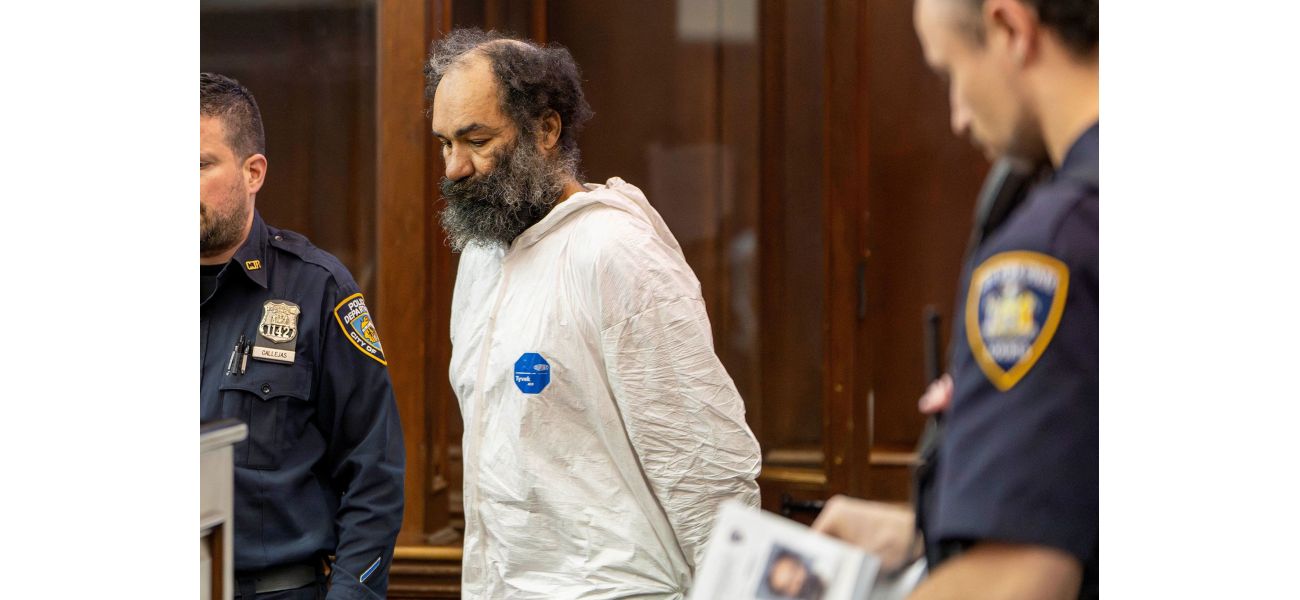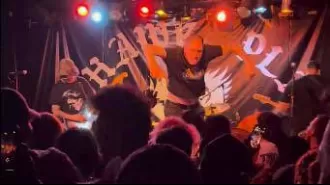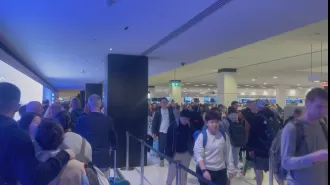Man's killing spree in NYC exposes city's corrupt system, leaving many homeless.
Police say a recently released inmate, Ramon Rivera, with a tall and unkempt appearance and a salt-and-pepper beard, approached a construction worker and stabbed him to death without speaking.
November 24th 2024.

Ramon Rivera was a tall and unkempt man, sporting a scruffy salt-and-pepper beard. He had just been released from jail after serving a month's sentence when he unexpectedly approached a construction worker on a Monday morning and stabbed him to death without uttering a word, according to police reports.
But that was not the end of his violent spree, as he continued to wreak havoc on the city. The mild autumn morning turned into an urban nightmare as the 51-year-old made his way across Manhattan and, more than two hours later, fatally stabbed a fisherman and a woman sitting on a park bench, police and prosecutors said. His clothes were drenched in blood when he was finally apprehended by the police, who found two bloody kitchen knives in his possession.
New York City Mayor Eric Adams described Rivera as a homeless man with a criminal history and severe mental health issues, citing him as an example of the failures of the criminal justice and mental health systems. These seemingly random killings have brought to light the challenges faced by New York City and other municipalities as they try to balance the rising issues of homelessness and mental illness and their impact on public safety.
Mary Brosnahan, a longtime leader of the Coalition for the Homeless, an advocacy and service organization, expressed her concern and frustration at the lack of change despite constant promises of improvement. She believes that these tragic incidents only add to the sense of insecurity felt by the public.
Joining the call for accountability, Rep. Jerrold Nadler, a Democrat representing the area where the stabbings occurred, along with several other city and state elected officials, wrote a letter demanding answers. They pointed out the failures of the criminal justice and mental health systems, echoing the sentiments of the mayor. They believe that these deaths could have been prevented.
During the investigation, Mayor Adams stated that they will be looking into why Rivera was on the streets in the first place. This raises questions about the criminal justice system's handling of his case.
A month before his alleged rampage, Rivera stood in a Manhattan courtroom, having just served eight months for burglary and an attempted assault on a correction officer. He was in court for the alleged theft of a $1,500 acrylic bowl that occurred before his jail stint. Despite his troubled history, he was released due to time served.
It was later revealed that Rivera had spent time in the Bellevue prison ward in Manhattan for assault while serving his sentence at Rikers Island. He had eventually pleaded guilty and was sentenced to 90 days, which he completed last month.
During his arraignment, Rivera's Legal Aid Society attorney argued for a less restrictive level of supervision, citing his struggles with housing and food insecurity, as well as keeping a regular schedule. The judge ordered supervised release, a program aimed at providing support for people with pending cases. However, Rivera's rap sheet showed six previous failures to appear in court.
Despite the judge's concerns, they did not want to set him up for failure and hoped that he would receive the necessary services and show up for his court date in December.
It is unclear what services, if any, Rivera received during the month leading up to the stabbings. The Manhattan supervised release program responsible for his case has not yet responded to requests for comment.
During his October arraignment, Rivera's lawyer mentioned that he was staying at the city's intake center for homeless men in Manhattan. However, the New York City Department of Social Services, which oversees the Department of Homeless Services, cited privacy and social services laws for not disclosing information about their clients.
On Tuesday, Rivera was back in court, this time facing three counts of first-degree murder. The prosecutor described his actions as a bloody and violent rampage that took the lives of three innocent New Yorkers going about their day. He was indicted on Friday and is scheduled for another court appearance in December.
During the arraignment, the judge mentioned Rivera's previous court appearance, where he was placed on the highest level of supervised release. However, the charges in the larceny case were not eligible for bail, meaning he could not be held behind bars unless convicted.
The 2019 legislation in New York state aimed to remove or limit the use of cash bail for defendants accused of misdemeanors or nonviolent offenses, ensuring that they are not held in jail solely because they cannot afford bail. However, this reform has faced criticism in the wake of Rivera's case, with some questioning if it was too lenient.
The Vera Institute of Justice, a nonpartisan research foundation, has stated that the bail reform made release before trial automatic for most people accused of misdemeanors and nonviolent felonies. However, it has since been amended to allow judges more discretion in deciding when to institute cash bail.
Ramon Rivera was a tall and unkempt man, sporting a scruffy salt-and-pepper beard. Just one month after being released from jail, he approached a construction worker on a quiet Monday morning and fatally stabbed him without uttering a single word, according to police reports.
But this was not the end of his violent rampage. As the day unfolded, a nightmare was unleashed upon the bustling streets of New York City. Rivera, who was 51 years old, continued his deadly spree, making his way across Manhattan. More than two hours later, he allegedly stabbed a fisherman and a woman sitting peacefully on a park bench, both of whom tragically lost their lives.
When Rivera was finally arrested, his clothes were drenched in blood and he was found in possession of two kitchen knives, according to the police. It was later revealed that he was a homeless man with a history of criminal behavior and severe mental health issues. New York City Mayor Eric Adams denounced the incident as a failure of the criminal justice and mental health systems, and an example of the challenges faced by municipalities in dealing with homelessness and mental illness.
The seemingly random nature of these killings has sparked concern and fear among the residents of New York City. Mary Brosnahan, who has been advocating for the homeless for over three decades, expressed her frustration with the lack of tangible change and the recurring tragedies that occur every few months. "We always hear that something is being done, but nothing seems to change, and then something unthinkable happens again," she said.
Rep. Jerrold Nadler, a Democrat representing the area where the stabbings occurred, joined a group of city and state elected officials in demanding accountability for the tragedy. In a letter addressed to the authorities, they stated that Rivera's case was a clear indication of the failures of the criminal justice and mental health systems in New York City. They also suggested that the three deaths could have been prevented.
As authorities continue to investigate the incident, Mayor Adams has vowed to uncover the reasons behind Rivera's release onto the streets. "We need to determine why he was on the street," he said. Meanwhile, a month before the deadly rampage, Rivera had appeared in court for a different case. After serving time for burglary and assaulting a correction officer, he was facing charges for the theft of a $1,500 acrylic bowl. However, due to time served, he was released on the day of his court appearance.
Rivera's Legal Aid Society attorney argued for a less restrictive level of supervision, citing his client's struggles with housing and food insecurity, as well as difficulty maintaining a regular schedule. While the judge ordered supervised release, she also noted Rivera's six previous failures to appear in court. Despite this, the judge wanted to give him a chance and urged him to connect with services and attend his next court date in December.
It is unclear what services, if any, Rivera received in the month leading up to the stabbings. However, it was revealed that he was staying at a homeless shelter in Manhattan. The New York City Department of Social Services, which oversees the Department of Homeless Services, stated that they could not comment on an ongoing investigation and were unable to disclose client information due to privacy laws.
On Tuesday, Rivera appeared in court once again, this time facing three counts of first-degree murder. According to the prosecutor, he had carried out a bloody and violent rampage, taking the lives of three innocent New Yorkers who were simply going about their day. He has since been indicted and will appear in court again in December.
The judge at the arraignment referred to Rivera's previous court appearance, stating that the larceny case was not eligible for bail. The previous judge had placed him on the highest level of the supervised release program, which is meant to provide support and supervision for individuals with pending cases. However, the charges in the larceny case were not bail eligible, and Rivera could not be held behind bars unless convicted.
In recent years, New York state has implemented bail reforms to ensure that defendants are not held in jail solely because they cannot afford bail. While these reforms aim to prevent unnecessary pre-trial detention, they have also faced criticism for potentially putting dangerous individuals back on the streets. The case of Ramon Rivera highlights the delicate balancing act faced by authorities in dealing with homelessness, mental illness, and public safety.
But that was not the end of his violent spree, as he continued to wreak havoc on the city. The mild autumn morning turned into an urban nightmare as the 51-year-old made his way across Manhattan and, more than two hours later, fatally stabbed a fisherman and a woman sitting on a park bench, police and prosecutors said. His clothes were drenched in blood when he was finally apprehended by the police, who found two bloody kitchen knives in his possession.
New York City Mayor Eric Adams described Rivera as a homeless man with a criminal history and severe mental health issues, citing him as an example of the failures of the criminal justice and mental health systems. These seemingly random killings have brought to light the challenges faced by New York City and other municipalities as they try to balance the rising issues of homelessness and mental illness and their impact on public safety.
Mary Brosnahan, a longtime leader of the Coalition for the Homeless, an advocacy and service organization, expressed her concern and frustration at the lack of change despite constant promises of improvement. She believes that these tragic incidents only add to the sense of insecurity felt by the public.
Joining the call for accountability, Rep. Jerrold Nadler, a Democrat representing the area where the stabbings occurred, along with several other city and state elected officials, wrote a letter demanding answers. They pointed out the failures of the criminal justice and mental health systems, echoing the sentiments of the mayor. They believe that these deaths could have been prevented.
During the investigation, Mayor Adams stated that they will be looking into why Rivera was on the streets in the first place. This raises questions about the criminal justice system's handling of his case.
A month before his alleged rampage, Rivera stood in a Manhattan courtroom, having just served eight months for burglary and an attempted assault on a correction officer. He was in court for the alleged theft of a $1,500 acrylic bowl that occurred before his jail stint. Despite his troubled history, he was released due to time served.
It was later revealed that Rivera had spent time in the Bellevue prison ward in Manhattan for assault while serving his sentence at Rikers Island. He had eventually pleaded guilty and was sentenced to 90 days, which he completed last month.
During his arraignment, Rivera's Legal Aid Society attorney argued for a less restrictive level of supervision, citing his struggles with housing and food insecurity, as well as keeping a regular schedule. The judge ordered supervised release, a program aimed at providing support for people with pending cases. However, Rivera's rap sheet showed six previous failures to appear in court.
Despite the judge's concerns, they did not want to set him up for failure and hoped that he would receive the necessary services and show up for his court date in December.
It is unclear what services, if any, Rivera received during the month leading up to the stabbings. The Manhattan supervised release program responsible for his case has not yet responded to requests for comment.
During his October arraignment, Rivera's lawyer mentioned that he was staying at the city's intake center for homeless men in Manhattan. However, the New York City Department of Social Services, which oversees the Department of Homeless Services, cited privacy and social services laws for not disclosing information about their clients.
On Tuesday, Rivera was back in court, this time facing three counts of first-degree murder. The prosecutor described his actions as a bloody and violent rampage that took the lives of three innocent New Yorkers going about their day. He was indicted on Friday and is scheduled for another court appearance in December.
During the arraignment, the judge mentioned Rivera's previous court appearance, where he was placed on the highest level of supervised release. However, the charges in the larceny case were not eligible for bail, meaning he could not be held behind bars unless convicted.
The 2019 legislation in New York state aimed to remove or limit the use of cash bail for defendants accused of misdemeanors or nonviolent offenses, ensuring that they are not held in jail solely because they cannot afford bail. However, this reform has faced criticism in the wake of Rivera's case, with some questioning if it was too lenient.
The Vera Institute of Justice, a nonpartisan research foundation, has stated that the bail reform made release before trial automatic for most people accused of misdemeanors and nonviolent felonies. However, it has since been amended to allow judges more discretion in deciding when to institute cash bail.
Ramon Rivera was a tall and unkempt man, sporting a scruffy salt-and-pepper beard. Just one month after being released from jail, he approached a construction worker on a quiet Monday morning and fatally stabbed him without uttering a single word, according to police reports.
But this was not the end of his violent rampage. As the day unfolded, a nightmare was unleashed upon the bustling streets of New York City. Rivera, who was 51 years old, continued his deadly spree, making his way across Manhattan. More than two hours later, he allegedly stabbed a fisherman and a woman sitting peacefully on a park bench, both of whom tragically lost their lives.
When Rivera was finally arrested, his clothes were drenched in blood and he was found in possession of two kitchen knives, according to the police. It was later revealed that he was a homeless man with a history of criminal behavior and severe mental health issues. New York City Mayor Eric Adams denounced the incident as a failure of the criminal justice and mental health systems, and an example of the challenges faced by municipalities in dealing with homelessness and mental illness.
The seemingly random nature of these killings has sparked concern and fear among the residents of New York City. Mary Brosnahan, who has been advocating for the homeless for over three decades, expressed her frustration with the lack of tangible change and the recurring tragedies that occur every few months. "We always hear that something is being done, but nothing seems to change, and then something unthinkable happens again," she said.
Rep. Jerrold Nadler, a Democrat representing the area where the stabbings occurred, joined a group of city and state elected officials in demanding accountability for the tragedy. In a letter addressed to the authorities, they stated that Rivera's case was a clear indication of the failures of the criminal justice and mental health systems in New York City. They also suggested that the three deaths could have been prevented.
As authorities continue to investigate the incident, Mayor Adams has vowed to uncover the reasons behind Rivera's release onto the streets. "We need to determine why he was on the street," he said. Meanwhile, a month before the deadly rampage, Rivera had appeared in court for a different case. After serving time for burglary and assaulting a correction officer, he was facing charges for the theft of a $1,500 acrylic bowl. However, due to time served, he was released on the day of his court appearance.
Rivera's Legal Aid Society attorney argued for a less restrictive level of supervision, citing his client's struggles with housing and food insecurity, as well as difficulty maintaining a regular schedule. While the judge ordered supervised release, she also noted Rivera's six previous failures to appear in court. Despite this, the judge wanted to give him a chance and urged him to connect with services and attend his next court date in December.
It is unclear what services, if any, Rivera received in the month leading up to the stabbings. However, it was revealed that he was staying at a homeless shelter in Manhattan. The New York City Department of Social Services, which oversees the Department of Homeless Services, stated that they could not comment on an ongoing investigation and were unable to disclose client information due to privacy laws.
On Tuesday, Rivera appeared in court once again, this time facing three counts of first-degree murder. According to the prosecutor, he had carried out a bloody and violent rampage, taking the lives of three innocent New Yorkers who were simply going about their day. He has since been indicted and will appear in court again in December.
The judge at the arraignment referred to Rivera's previous court appearance, stating that the larceny case was not eligible for bail. The previous judge had placed him on the highest level of the supervised release program, which is meant to provide support and supervision for individuals with pending cases. However, the charges in the larceny case were not bail eligible, and Rivera could not be held behind bars unless convicted.
In recent years, New York state has implemented bail reforms to ensure that defendants are not held in jail solely because they cannot afford bail. While these reforms aim to prevent unnecessary pre-trial detention, they have also faced criticism for potentially putting dangerous individuals back on the streets. The case of Ramon Rivera highlights the delicate balancing act faced by authorities in dealing with homelessness, mental illness, and public safety.
[This article has been trending online recently and has been generated with AI. Your feed is customized.]
[Generative AI is experimental.]
0
0
Submit Comment





